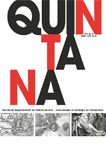Las mujeres caídas como herederas de María Magdalena en el audiovisual (1910-1919)
Contido principal do artigo
Resumo
Las imágenes actúan como focos de influencia para la creación de otras imágenes, historias o personajes (Fritz Saxl). Este es el caso de la mítica Magdalena, quien ha funcionado como agente contaminante para crear toda una estirpe de herederas, entre las que se encuentran las mujeres caídas. Estos personajes viven su auge en la literatura decimonónica, teniendo también su presencia en la pintura de esa misma cronología. Después, saltarán al cine con un importante momento de auge en la segunda década del siglo XX. NO ME PERMITE TERMINAR DE INCLUIR EL RESUMEN
Palabras chave
Detalles do artigo
Citas
Andres, Sophia. The pre-Raphaelite Art of the Victorian Novel. Narrative Challenges to Visual Gendered Boundaries. Columbus: The Ohio State University Press, 2005.
Bernabé, Carmen. María Magdalena. Tradiciones en el cristianismo primitivo. Estella: Verbo Divino, 1994.
Bornay, Erika. Las hijas de Lilith. Madrid: Cátedra, 1990.
Campbell, Marilyn. The Fallen Woman in Hollywood Films, 1931-1933. Madison: University of Wisconsin-Madison, 1974.
Campbell, Russell. Marked Women: Prostitutes and Prostitution in the Cinema. Madison: University of Wisconsin Press, 2006.
Collins, William W. Armadale. Leipzig: Bernhard Tauchnitz, 1863.
Collins, William W. No Name. Leipzig: Bernhard Tauchnitz, 1863.
Collins, William W. The New Magdalen. Leipzig: Bernhard Tauchnitz, 1863.
Emerson, John y Loos, Anita. “What Makes a Photograma.” Motion Picture Magazine (February-July, 1921): 60-61.
Jacobs, Lea. The Wages of Sin: Censorship and the Fallen Woman Film, 1928-1942. Berkeley – Los Angeles: University of California Press, 1997.
Logan, Deborah A. Fallenness in Victorian Women’s Writing: Marry, Stitch, Die, or Do Worse. Columbia – London: University of Missouri Press, 1998.
Flower, Newman W. Is God Dead? Londres: Casell, 1915.
García Mahíques, Rafael. Iconografía e Iconología. Volumen 1. La Historia del Arte como Historia Cultural. Madrid: Encuentro, 2008.
Gaskell, Elizabeth. Mary Barton. A Tale of Manchester Life. London: Chapman & Hall, 1848.
Hapke, Laura. “He Stoops to Conquer: Redeeming the Fallen Woman in the Fiction of Dickens, Gaskell and Their Contemporaries.” Victorian Newsletter 69 (1986): 16-22.
Haskins, Susan. María Magdalena. Mito y metáfora. Barcelona: Herder, 1996.
Hebbel, Friedrich. Maria Magdalene. Einbürgerliches Trauerspiel in drei Akten. Hamburg: Hoffmann und Campe, 1844.
Lombardi, Frederic. Allan Dwan and the Rise and Decline of the Hollywood Studios. Jefferson– London: McFarland, 2013.
McLaughlin, Robert. The Eternal Magdalene. A Modern Play in Three Acts. New York: S. French, 1918.
Maisch, Ingrid. Between Contempt and Veneration. Mary Magdalene. The Image of a Woman through the Centuries. Collegeville: The Liturgical Press, 1998.
Oderman, Stuart. Lillian Gish: A Life on Stage and Screen. Jefferson: McFarland, 2000.
Ricci, Carla. Mary Magdalene and Many Others. Women who Followed Jesus. Minneapolis: Fortress Press, 1994.
Saxl, Fritz. La vida de las imágenes. Estudios iconográficos sobre el arte occidental. Madrid: Alianza, 1989.
Schaberg, Jane. La resurrección de María Magdalena. Leyendas, apócrifos y testamento cristiano. Estella: Verbo Divino, 2008.
Trudgill, Eric. Madonnas and Magdalens: The Origins and Development of Victorian Sexual Attitudes. London: Heinemann, 1976.
Vorágine, Santiago. La Leyenda Dorada, 1. Madrid: Alianza, 2001.
Walkowitz, Judith. “Sexualidades peligrosas.” En Historia de las mujeres. El siglo XIX. Vol. 4, editado por Georges Duby y Michelle Perrot, 389-426. Madrid: Taurus, 1993.
Warburg, Aby. El renacimiento del paganismo. Aportaciones a la historia cultural del Renacimiento europeo. Madrid: Alianza, 2005.
Watt, George. The Fallen Woman in the Nineteenth-Century English Novel. London - New York: Routledge, 1984.







